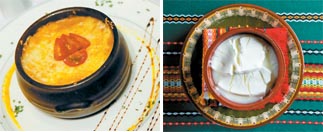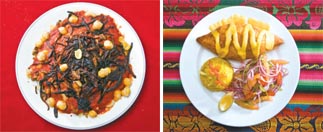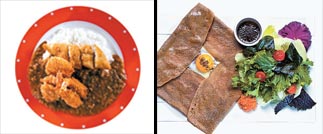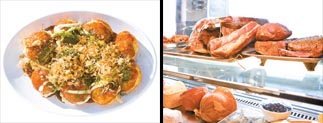Where homesick hearts and taste buds gather

Almost daily tango dancing adds a cultural spice to the Argentinian restaurant Buenos Aires in Seoul. Photos by Kwon Hyuk-jae
And today Seoul has more authentic ethnic restaurants, run by entrepreneurs from faraway lands, than ever before.
But these colorful venues aren’t just a place to relieve your ache for a seafood ceviche or Argentinian steak. Some also offer cultural bonuses, like hookah or tango dancing. And of course, they’re a great place for native Koreans to broaden their horizons too.
Charles Dubal, 50, is one of these entrepreneurs. Three months after he opened a Brittany-style crepe restaurant with his friend Yoo Young-jin, he remembered the series of coincidences that led him to Korea.
“If it weren’t Seoul, I might have been making crepes in Kenya,” Dubal joked.
Last summer, he met Yoo, 27, while they were attending the same baking school in Normandy, France, and they ended up opening the restaurant together, Dubal said. He said he had lived in Turkey and Scandinavia before, and thus was prepared for the big move to Seoul.
Dubal cannot speak Korean and he is always frustrated at his inability to explain to his customers how to eat his crepes, which he’s immensely proud of - though not as much as his homeland of Brittany, a region in northwest France. When he meets a customer who can speak French, he always starts a spirited conversation about the region, taking out maps and even showing off a tour guidebook.
Still, despite the language barrier, Dubal said he has learned something about Korean culture. “In Korea, women seem to dominate in decision making over where and what to eat,” he said.
Also in Seodaemun three months ago, Michiko Suzuki, 67, opened Satoshi Curry near Hongik University. Suzuki’s primary goal, she said, is authenticity - she has stuck to her original Osaka-style recipe with no concessions to local tastes, and travels to Japan every three months to buy ingredients. Like most Japanese curry, her concoction is relatively sweet, and she serves Japanese side items like croquettes and shrimp fries.
Another Japanese restaurant in Seodaemun, Daepanok, is run by a Japanese man and his Korean wife near Ewha Womans University. It serves Osaka-style takoyaki, balls of dough with octopus at the center; okonomiyaki savory pancakes, and ramen. The customers are mostly students, and all 10 seats are occupied most of the time.
Christian Meilinger, a 46-year-old Austrian, runs Chef Meili, a homemade sausage and ham shop in Itaewon, with his Korean wife. The first floor is that rarest of Seoul retailers - a deli, where the sausage and ham are made - and the second and third floors are the restaurant.
By Lee Ka-young, Lee Do-eun [jbiz91@joongang.co.kr]

Argentinian pastel at Buenos Aires / Zelen’s traditional Bulgarian yogurt
The clientele here is as diverse as Latin America itself, with the sound of happy Spanish chatter always in the background. There are also many Korean regulars.
The restaurant serves thick Argentinean-style steak with three traditional sauces. According to the owner, even officials from the Argentinean Foreign Ministry, who visited the place last August, have complimented the steak.
But the food isn’t the only draw to Buenos Aires, which holds tango dancing at 9 p.m. on Mondays and Thursdays, at 9 and 10:30 p.m. on Fridays and 8 and 10 p.m. on Saturdays. A steak is priced at 28,000 won ($25). It’s located behind Riverside Hotel in Jamwon-dong, Seocho District, southern Seoul. The 60 seats are always full, so call ahead at (02) 3444-6634.
Zelen
A white wall, green window and red sunshade, representing the three colors of the Bulgarian national flag, declare Zelen’s origins, and the restaurant has become a sort of home base for Bulgarian expats, holding welcoming parties whenever a newcomer arrives.
“Bulgarians who come here say the food tastes better than the dishes their mothers cooked,” said the owner, Mihal Ashminov, 28. “I think it’s because it is hard to find Bulgarian food in Korea.”
Some popular menu items include the shopska salad, a mix of tomato, cucumber, baked sweet pepper and olive oil (12,000 won), and the kifte meatball, with ground beef and pork and various spices (14,000 won). Special yogurt is also served for 5,000 won. Take line No. 6 to Itaewon Station, exit 1. Call (02) 749-0600 for more details.

Kushari, a rice and lentil dish / A potato croquette at Cusco
Ali Baba
Huge Tutankhamen and Sphinx statues and exotic lamps loudly broadcast Ali Baba’s Egyptian roots.
Khalid Ali, a 42-year-old former employee of the Egyptian Chamber of Commerce in Korea, opened the restaurant with his Korean wife nine years ago.
Ali said Egyptian foods have less spice but more garlic and onion than other Middle Eastern cuisines. The place sees diners from countries like Libya, Lebanon, Algeria, Tunisia, Morocco and Saudi Arabia. It also holds belly dancing performances, with reservations required.
Four falafel - fried balls made from spiced chickpeas eaten with yogurt and pita bread - cost 8,000 won.
The restaurant is located in front of the Itaewon fire station. Call (02) 790-7754.
Cusco
This Peruvian restaurant is decorated with a large picture of Machu Picchu and a mural depicting Incan myths.
When it opened in 2003, most of the customers were illegal migrant workers from Peru (a situation the owner claimed has been rectified). The Peruvian chef takes special pride in the salty dishes, explaining that in Peru, salt is precious and there is a tradition of serving salty foods to important guests. Ceviche seafood salad with celery, garlic and seafood pickled in lemon sauce is a popular menu item. Peruvians are said to eat ceviche to overcome hangovers but in Korea it’s known better as an appetizer before drinking. It costs 17,000 won per person. Go to Hapjeong Station on line No. 2 or 6, exit 6, and call (02) 334-2093 for more information.

Curry rice with a croquette on top / The Crepe Complete set
Satoshi Curry
The most popular dish here, appropriately, is Satoshi Curry, a simple rice and curry platter that comes recommended by the owner. If it is not filling enough, add a croquette on top.
Satoshi curry costs 6,000 won, and the Satoshi special, which comes with curry, rice and fried shrimp and clams, is 12,000 won.
The restaurant is located on the first floor of the Purgio complex in front of Hongik University’s main gate. Call (02) 322-6824.
La Celtique
La Celtique serves galette, a flat, round crusty cake normally made of buckwheat, cheese and seafood. The restaurant also serves buckwheat crepes.
Its Crepe Complete is the most common crepe configuration eaten in France, with egg and bacon.
The Crepe Complete sells for 8,500 won. The restaurant is on the second floor of a building in front of an overpass near Yonsei University. Call (02) 312-7774 for directions.

Takoyaki, balls of dough with octopus / Chef Meili’s first floor deli
Daepanok
The Japanese owner of Daepanok cooks takoyaki himself while his Korean wife boils ramen. A 3,500 won platter comes with 10 spheres of the classic Kansai street food.
A set menu that consists of miso and soy sauce ramen and five takoyaki balls is 5,000 won. Most other menu items are priced at 3,500 won to 5,000 won.
The restaurant is located right beside Mr. Pizza in front of Ewha Womans University. Call (018) 216-4770.
Chef Meili
Chef Christian Meilinger, 46, makes 30 kinds of ham and sausages, including Thuringer sausage, spicy Italian sausage and salami. Most popular here are the Nuremberg roast sausages and Munich sausages.
For newcomers, the chef recommends a Sausage Platter for 14,500 won. Roesti, a traditional Swiss potato dish, costs 16,500 won. The restaurant is located next to Industrial Bank of Korea in Itaewon (Itaewon Station, line No. 6, exit 4). Call (02) 794-7024.
타향에선 고향음식을 파는 곳이 고향이다. 세계 각국 사람들이 모여드는 서울엔 그래서 아주 멀고도 낯선 나라의 음식점들이 곳곳에 스며들어 있다. 이방인들에겐 향수를 달래 주는 고향이 되고, 한국인들에겐 훌쩍 떠나고픈 이방을 느끼게 하는 이색지대들이다. 서울에 하나밖에 없는 이방인들의 고향을 찾아봤다.
http://article.joins.com/article/article.asp?total_id=3963700










with the Korea JoongAng Daily
To write comments, please log in to one of the accounts.
Standards Board Policy (0/250자)